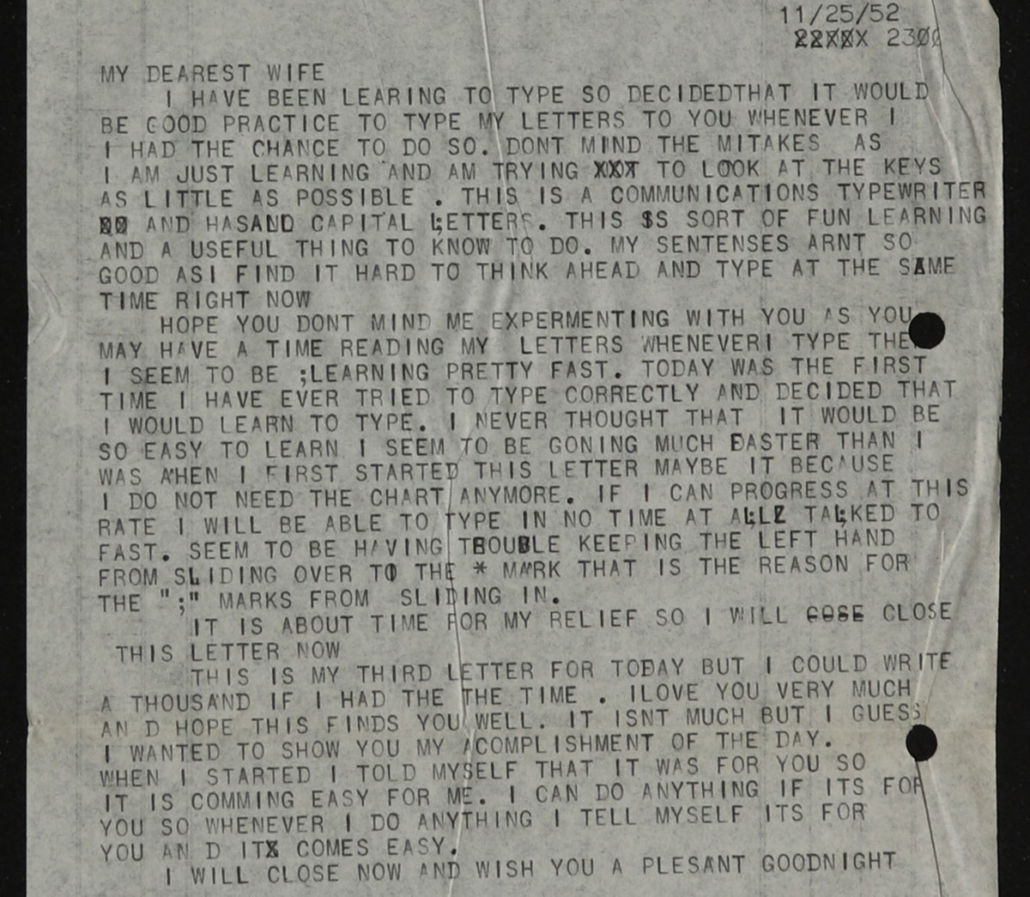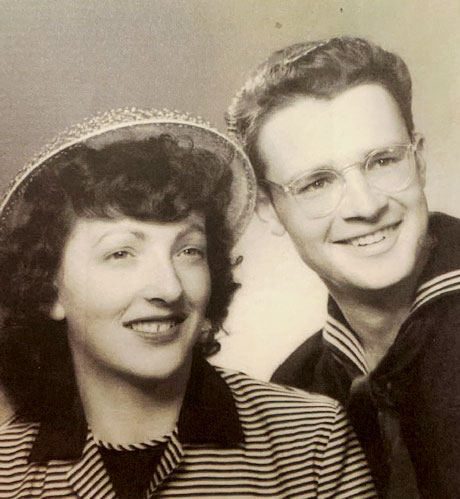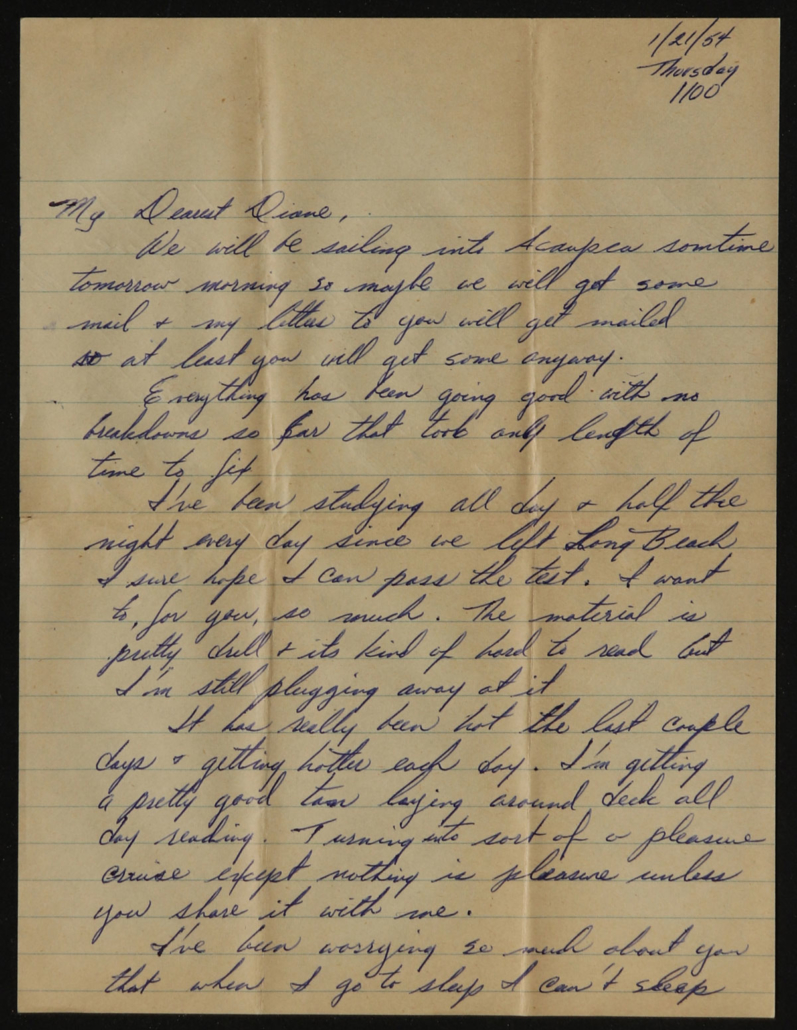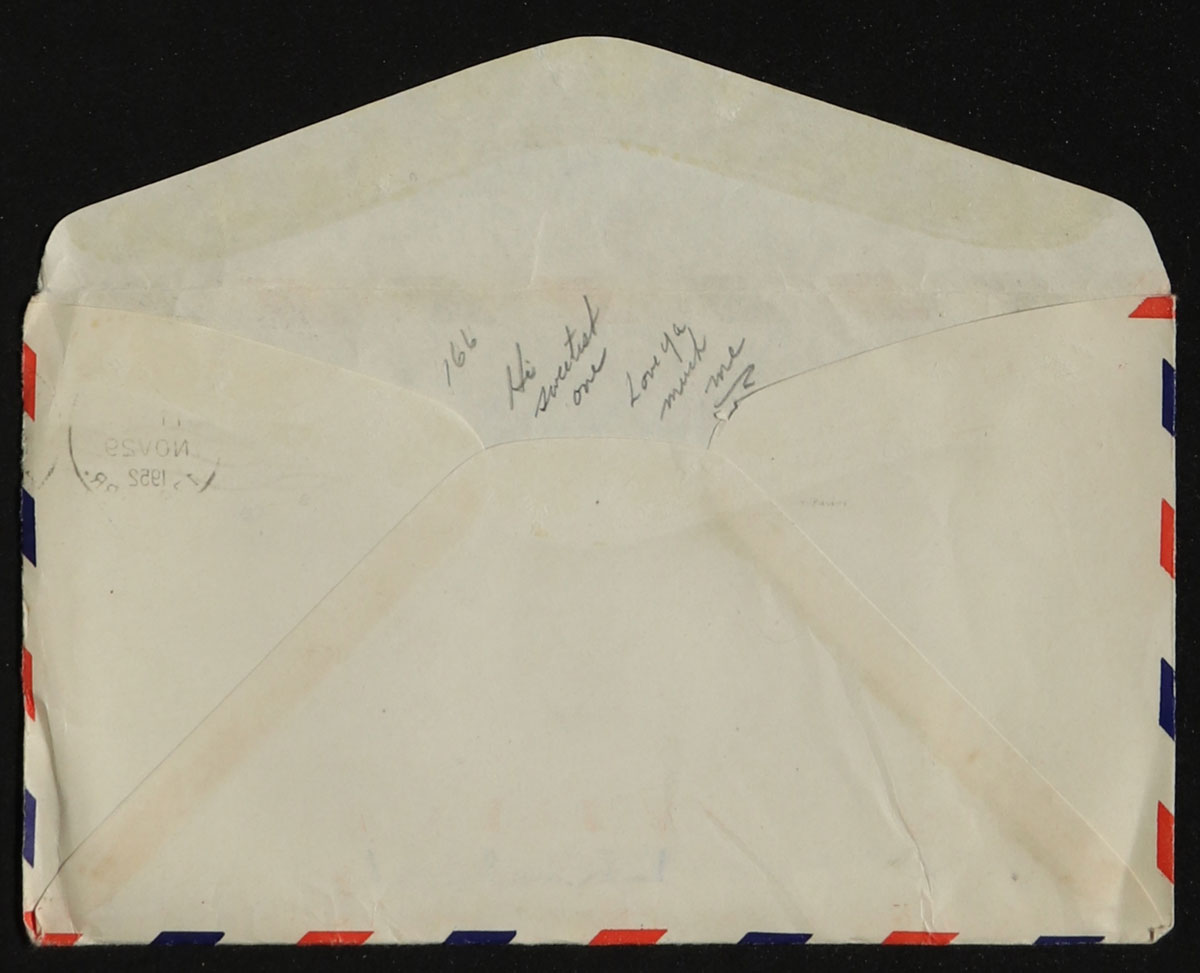The power of human connection is stronger than ever after such a disruptive year. It’s hard to feel close to loved ones when, over the course of a life, people spread out and go in their own directions. Historical collections can show us that those connections are still powerful and tangible even from afar.
We sat down to talk about this and more with Rosemary Cassie, one of Anderson Archival’s recent clients. Her collection of letters written by her father while he was on a US Navy minesweeper during the Korean war reminded us that the powerful connections we make in our lives can foster new connections, even after we are gone.
Now that the digitization of these love letters is complete, Cassie shares the collection virtually with her entire extended family. The group meets twice a month via Zoom and reads selections from the collection together and discuss the members of their family that left the record of their lifelong love behind.
AA: What’s it been like to be able to share the collection digitally with your entire family?
Since both my parents have passed, these letters were my way of kind of keeping us connected. When you lose the matriarch or the patriarch of a family, there’s really not that pull to stay together.
People don’t think a lot about building that connection with a family that’s dispersed, especially during a pandemic. What a role these letters have played in a time when we haven’t even been able to have a service or a mass for my mom. We’ve been able to have a memorial weekend—memorialized both of them, actually—in a way that probably we wouldn’t have done if we hadn’t been in the middle of a pandemic.
I download every year’s worth of letters from Box, and then share them with the family on Google Drive in small chunks. Then we all get on a Zoom call and discuss. When we’re on a particular letter or theme, I’ll open up to that letter, to that month, and we’ll make comments on it. We always start the call with the letters in mind, and then we always then transition to more things about what’s going on in our own lives, almost like our own video version of the letters.
This is my way of everybody getting the letters. Even some of my family who don’t choose to be part of the Zoom call are reading the letters. All my immediate siblings are participating, but it’s my nieces and nephews who are spread around the world that aren’t as involved. Now they have they have a part of our family’s history that they can keep.
AA: What was unique about the digitization process for this collection?
In addition to the letters themselves, the digitization team would photograph the big front and the back of the envelope for two reasons. The front of the envelopes have the post mark, and the back of the envelope would always have little love notes.
AA: On our end, the process of capturing these details ended up telling us a lot about your mother. She opened the envelopes with a letter opener, and occasionally made notes about the contents of the letter on the envelope itself. I remember the day one of our team members found a hidden love note that, from the way the envelope was opened, she had never seen. When our team member shared that find with the rest of us, we were floored. You can just feel how much love is in all those letters, even in a note that was never seen before.
Both my parents were pretty progressive as a couple. My mom and dad only knew each other three months before they got married, and he shipped out for two years.

AA: Wow. That’s a strong love, this young love built from three months.
Yeah, and it stayed that way, never veered away from that. I just I wish we had her side of the letters. My dad kept my mothers’ letters, so we only have one part of the story. We’re always trying to figure out, “What did my mom’s say?” But in a way, it kind of makes it more interesting to only have his because then you have to speculate or create your own version of what you think Mom would have said. You have to fill in the gaps like, “Oh, I wonder what made him sick, or what he’s responding to from her last letter.”
My brother and brother-in-law are both ex-Navy men as well. When we’ve talked about my dad mentioning something about the ship or protocols, my brother-in-law and brother will help translate. Later on in the letters, he talks about studying for his certifications. My niece was reading about this study and how my dad was so worried that he wasn’t going to pass. My dad was brilliant. He passed every test. But my niece was like, “I have to get to those parts of the letters.”
AA: She was enthralled with the story! Wow! It is so wonderful that you all can share this intimate collection of love letters. How did it first come into your possession?
I knew the letters existed but didn’t really know where they were and I hadn’t seen them. Since April, my mother had them hidden away. I moved her into my home because of COVID-19, and as her health declined, she really couldn’t speak anymore. Then she passed away, right at the end of April last year.

AA: They must have meant a lot to her to keep them kept close for so many years. Did she talk about them at all towards the end of her life?
About two weeks before she passed, she kept asking for them. She had a brain tumor, so she was fading fast. What seemed to really make her calmer is whenever the family came to visit, I would pull out the letters and they would read from them. What made me think of wanting to digitize them was everyone asking who will inherit the letters. I’m like, “Well, everybody should have the letters.” It was my daughter-in-law’s idea to find an archivist.
AA: How was the collection stored when it was in your mother’s possession, and what was your approach going forward?
They were in her dresser drawer. Literally in the plastic bags you get when you buy comforters and blankets. They were tied with bows, and they were somewhat in chronological order.
When I was talking with Mark [Anderson, Founding Principal of Anderson Archival] about the project and he was telling me his process, I said, “Well, they’re getting fragile. When you’re done with the letters, instead of folding them back up and putting them in the original envelopes and shipping them back, what do you have to preserve them?”
Want to learn more about storing collections safely? We outline some of the best strategies.
The team did some research and what seemed like the most logical solution was to put them in plastic preservation sleeves and preservation boxes. What’s really cool about that is that it’s a binder, so it’s just faster than trying to maneuver to the computer. It’s so nice because when the family gets together, I have them right there.

AA: Have you and your family gained any insights or interesting anecdotes from approaching these letters together?
Oh, my God, yes. It’s so funny. First of all, everyone’s said how my dad’s cursive was very nice. I mean, he’s writing on a ship in pencil, probably in a two-by-two-foot space, and still had beautiful handwriting. About half the people in my family under 30 don’t even know how to read cursive.
And then there’s phrases or terminology that the younger kids don’t even know… A letter mentioned dungarees somewhere, and so my niece asked, “What are dungarees?” Or there was another word that my mom used instead of a dresser, “bureau,” that the younger kids weren’t familiar with.
But I think what we noticed right away was how romantic they are, and how it continued, no matter how long they were married—it was sixty-two years before my dad passed. In addition to the Korean War-era letters, the collection also included two letters that were from the 70s, and one from the 90s. And you wouldn’t even know there was all that much time difference, because they were still in that same tone.
The letters just keep giving us the opportunity to connect. The ability to read them chronologically without the hassle of opening them and unfolding them, and just the fact that we can scale it digitally is the number one benefit.
AA: Is there anything else that you want to share about your collection or the process?
I will just say that clarity is bar none. It’s so nice. The digital versions are much easier to read than the hard copies because you can zoom in there. The end result is so much better than I thought I would get because I’m used to like scanning from my multipurpose printer/scanner. They accommodated for the varying size of each letter and left a border around it so that you didn’t have to worry about [the image being cut off].
I really appreciated when the scanning was done, as you were working to put it together in additional formats, [your team] was very willing to arrange it in a way that would make sense to us. Again, I can’t say enough nice things about how impressed I was with the service and the communication back and forth throughout the project. It was all very professional, and I really appreciate that type of process.
AA: Well, thank you so much for taking the time to talk with us, Rosemary, and allowing us to work on this special collection. It was a pleasure.
That’ll be another topic for my family meeting. I can’t wait.
Whether they’re recorded in modern times or generations past, human emotions and connections will always stand the test of time. Do you have a family collection in need of digital preservation? Connect with us today!


